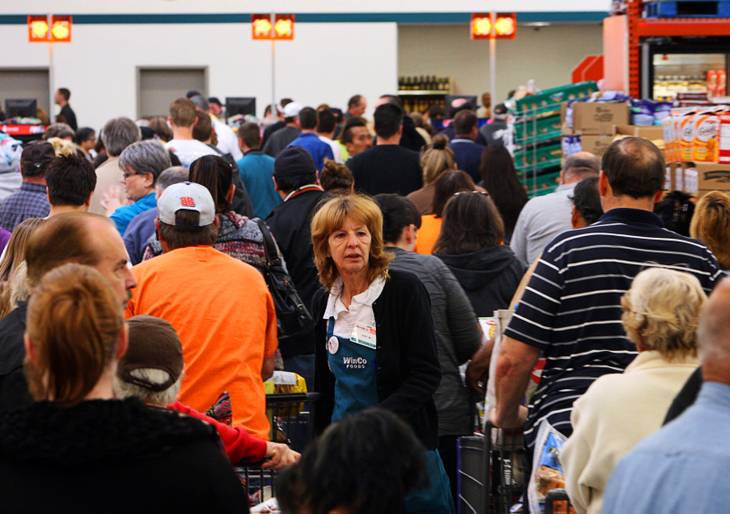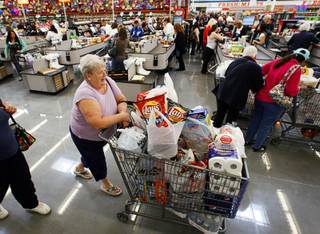When WinCo Foods opened two stores in Las Vegas this month, the scene at the company's new Henderson site was described in the Las Vegas Sun as looking like "Black Friday at a big box."
Lines of shoppers flanked the building, and the parking lot swarmed with cars. One shopper said: "It's like Christmas right now. We're going crazy."
But in a metro area that is home to at least 185 grocery stores, can WinCo establish a successful long-term presence in Las Vegas with its 24-hour-per-day, warehouse-style discount formula?
Can it succeed where the almost-forgotten Raley’s chain failed to establish a foothold, and where Fresh & Easy is still trying to come up with a winning lineup of stores?
Retail experts are divided on these questions.
Some say WinCo’s successful track record elsewhere is an indication it will profit and grow in Las Vegas, but others note Las Vegas is a no-growth market that already features a number of discount stores.
With just two stores in the Las Vegas area, at the northern and southern tips of the market, WinCo’s local reach is limited by geography for now.
''A lot of people were pretty excited to see them come, but they’re not in every neighborhood. So are people going to drive an extra 10 to 12 miles just to go to a WinCo? I don’t see that happening. We’re just not that market. We’re a market that’s based on convenience,'' said Nick Barber, a senior investment and leasing specialist at Gatski Commercial Real Estate Services.
Barber and Alyson Bettelman, a certified public accountant and senior manager at advisory firm Applied Analysis in Las Vegas, agreed there’s plenty for bargain hunters to like about WinCo with its large-format stores.
They run about 95,000 square feet, compared with the typical Walmart Supercenter, with 185,000 square feet. A good chunk of each Walmart outlet, of course, is devoted to non-grocery items not carried by WinCo.
The WinCos are smaller than Costcos and Sam’s Clubs, which run 130,000-plus square feet, but are larger than Fresh & Easy — typically 20,000 square feet — and such chain supermarkets as Smith’s, Albertsons and Vons, which run 60,000 to 65,000 square feet.
''Large store size is one of the most differentiating factors. WinCo focuses on large selection and an entire bulk foods department,'' Bettelman said.
She suggested that when it comes to customer service, WinCo may raise the bar in Las Vegas because it’s owned by its employees, who have an incentive to see customers return again and again.
''Employee-owned businesses tend to be known for higher quality service, as employees may have more of a sense of ownership or pride in their work,'' she said.
Pamela Joy Ring, a retail consultant and chief marketing officer at Las Vegas online marketing company BannerView.com, agreed with Barber that people for the most part wouldn’t drive long distances to shop at WinCo.
She said WinCo’s focus on low prices and its lack of certain amenities limited its potential appeal.
For instance, its stores don’t have pharmacies, in-store bank branches, hairstyling operations, manicuring salons or eye doctor offices.
Many grocery stores offer discount loyalty cards. WinCo does not. (But then, neither does Walmart).
To save money on bank fees, WinCo doesn’t accept credit cards. In order to avoid paying artistic licensing fees, it doesn’t even play music to entertain shoppers or to put them in a buying mood.
''We’re just a grocery store,'' said Michael Read, WinCo vice president of public and legal affairs.
Read added that there were a couple of entertainment-related exceptions in some stores.
One is that in some locations, Redbox movie kiosks are offered. And — unique to the chain's Nevada properties — WinCo has operated slot machines in its Reno stores and may do so in its Southern Nevada stores.
Overall, the new Southern Nevada stores appear to be super-sized versions of the Food 4 Less warehouse concept, complete with shoppers bagging their own groceries.
''This is not a destination for the experience you’ll have there or the diversity of the goods there,'' Ring said, explaining the two WinCo stores will most likely simply serve bargain-hunters in limited geographic areas of Las Vegas and Henderson.
Ring said the grocery store market WinCo competes in is extremely fragmented.
One shopper may favor the natural products at Whole Foods, another the loyalty program at Albertsons and another the service at Glazier’s.
With 14 massive Walmart Supercenters developed in the area as Las Vegas exploded with growth in the late 1990s and mid 2000s, there is plenty of opportunity for one-stop shopping at those locations for not just groceries but clothes and prescription drugs, she said.
These factors likely leave WinCo appealing to just a small, price-driven, piece of the overall market, Ring said.
Bettelman offered a similar take on why many Las Vegans won’t travel to WinCo.
''Existing neighborhood/community retailers retain an edge in terms of the convenience factor. Consumers who do their grocery shopping several times per week and buy relatively smaller quantities may have no interest in a low-price/bulk retailer such as WinCo,'' Bettelman said.
Barber, however, said WinCo’s lack of geographic reach in Las Vegas may be only a temporary problem.
''If they were to build five or six more stores, and fill in some of these pockets so people didn’t have to drive 12 miles to get to one of them, they would probably do pretty well,'' Barber said.
''I do expect them to (grow), because the cost is cheaper than it’s going to ever be for Las Vegas. But I think they’re going to see how these first two stores go,'' Barber said.
Look for growth here if WinCo follows the pattern here that it executed recently in the similar-sized Salt Lake City-area market.
In October 2009, WinCo opened two stores on the same day in the Salt Lake City-area towns of Midvale and West Valley City.
By the end of 2010 it had opened three more stores north and south of Salt Lake City in what’s called the Wasatch Front market. They’re in Ogden, Roy and Orem.
WinCo similarly entered the Las Vegas market by opening stores the same day, March 4, in Henderson and in the northern part of Las Vegas.
Read said similar growth in the Las Vegas area was a possibility.
''It’s a large market. Time will tell,'' he said.
The company could profit with more market share by increasing its local revenue and further leveraging its distribution costs. It doesn’t advertise extensively, so that’s not much of a factor in the potential expansion equation, Read said.
WinCo, with two stores in the Reno market since the 1990s, is a solid competitor there, said commercial real estate expert Chris Waizmann, a senior vice president at brokerage CBRE Inc. in Reno.
With Washoe County’s population of about 421,000 people, Waizmann said WinCo has considered expanding in the Reno-Sparks area, but hasn’t done so just because the potential customer base there isn’t large enough.
With Clark County’s population topping 1.95 million people, the Las Vegas area is probably a different story, Waizmann said.
''I have to think there’s room there for five or six stores,'' he said.
Las Vegas already offers about 185 stores, which includes Walmarts and Targets carrying groceries, ethnic markets and stores focused on natural food.
And as grocery store operators have seen, there’s more to success in Las Vegas than building and opening a store or rebranding an existing grocery store building.
In 1999, the Sacramento-based chain Raley’s entered the Southern Nevada market by taking over a group of former Albertsons stores. Within three years, Raley’s had given up on Las Vegas amid tough competition. Kroger Co. of Cincinnati picked up 18 of its stores and converted them to its Smith’s and Food 4 Less brands.
British grocer Tesco entered the Las Vegas market with its Fresh & Easy Neighborhood Markets concept in 2007, growing to 27 stores in part because of a deal to acquire 10 shuttered Rite Aid drugstores and convert them to the Fresh & Easy brand.
By October 2010, Fresh & Easy had identified six low-performing local stores it would close at least temporarily — though in parts of the Las Vegas Valley the company continued to add stores.
Barber, at Gatski Commercial Real Estate, is a former Albertsons manager with some special insight about what went wrong for Raley’s and Fresh & Easy — and how WinCo may be doing things right.
''With Raley’s, their problem was they brought in a lot of suppliers, a lot of wholesalers that people weren’t familiar with. We have a huge static demographic here and they didn’t have the products that those people had become accustomed to,'' Barber said. ''And the fact that Fresh & Easy had to close (some stores) was they went too big too fast.
''With Raley’s, it was kind of the same type situation. I think they saw an opportunity to come in and absorb a bunch of real estate and market share, and the local shopper just didn’t relate to the services and the products they were offering,'' Barber said. "I think opening up two stores as opposed to opening up 15 or 20 at one time is the right play for WinCo. They’re taking a conservative approach to this market, and I think that’s very smart. The reason they’re the company they are is they’re just not going to go too big too quick.''
Others are skeptical that WinCo will find that it makes financial sense to grow in Las Vegas.
That's because there's little or no economic growth foreseen locally in the next few years, and the city is already littered with monuments to failed retail plans in the form of empty grocery store buildings. In fact, the real estate vacancy rate of 10.6 percent is more than double the pre-recession rate.
To grow, WinCo will have to take more market share from the well-funded companies that currently dominate the local grocery market with their megabrands like Walmart, Smith’s, Food 4 Less, Albertsons and Vons.
''I don’t see it happening,'' Ring said. ''Las Vegas already is over-retailed. Las Vegas is overbuilt.''

